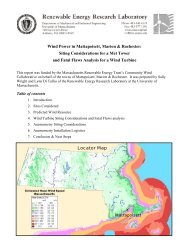Erickson-Indiana-bat
Erickson-Indiana-bat
Erickson-Indiana-bat
You also want an ePaper? Increase the reach of your titles
YUMPU automatically turns print PDFs into web optimized ePapers that Google loves.
our findings only examine one anthropogenic stressor affecting the stability of one species,<br />
similar trends are emerging world wide where anthropogenic stressors are affecting the<br />
stability, biodiversity, and productivity of Earth’s ecosystems (Dirzo et al., 2014; Harley,<br />
2011; Hautier et al., 2015).<br />
To capture the salient life history aspects of the <strong>Indiana</strong> <strong>bat</strong>, our FAC required significant<br />
effort at parameterization. This effort may be possible for other endangered species such as<br />
the whooping crane (Grus americana) (Nations, Howlin & Young, 2013), but is not easily<br />
scalable to the hundreds of species killed at wind turbines. For species where it is not possible<br />
to construct high-effort, high-input models, probably the first and most important question<br />
to ask would be, ‘‘what is the overlap between the species range and wind turbines?’’ As an<br />
example of such an assessment, Santos et al. (2013) applied spatial distribution modeling to<br />
examine four species of <strong>bat</strong>s and what factors affected the probability of mortality occurring<br />
at a given wind energy production facility. Similarly, work by Roscioni et al. (2013) modeled<br />
the regional effects of wind farms on <strong>bat</strong>s, and Roscioni et al. (2014) modeled the effects of<br />
wind farms on <strong>bat</strong> migration and population connectivity. As part of the spatial overlap<br />
question, it is also important to not only consider the ‘‘where,’’ but also the ‘‘when.’’<br />
Obviously, a species with no overlap is not directly at risk, but might be if wind energy<br />
generation adversely affects an important competitor or prey species.<br />
The other modeling efforts we described are similar in that they broadly seek to<br />
understand the impacts of wind energy development on wildlife. These efforts differed,<br />
however, in either their scale or modeling approaches. For example Nations, Howlin &<br />
Young (2013) constructed an individual-based model for an extremely rare species that<br />
would have more of a localized risk of wind turbine mortality. Santos et al. (2013) used<br />
species distribution models to examine spatial distribution and risk using distribution<br />
modeling rather than population modeling. Efforts by Roscioni et al. (2013); Roscioni et<br />
al. (2014) were similar to our in that they examined spatial migration and networks.<br />
Specifically, Roscioni et al. (2014) examined the spatial connectivity of a <strong>bat</strong> species in Italy<br />
and the possible effects of wind turbine development on the species. However, our approach<br />
differs from Roscioni et al. (2014) because we focused on the population dynamics of the<br />
species.<br />
Another important consideration is the spatial structure of the population: ‘‘Are there<br />
distinct subpopulations or is the species well connected across its range?’’ The <strong>Indiana</strong><br />
<strong>bat</strong> forms distinct subpopulations because of its life history, but other species such as<br />
long-distance migratory tree <strong>bat</strong>s or some avian species may not. This spatial connectivity<br />
is also important if one decides to consider the possibility of re-colonization of extirpated<br />
populations. The third important consideration that emerges from our results would be,<br />
‘‘What are the other stressors affecting the population and how do they interact with wind<br />
energy production?’’<br />
Due to the large number of parameters in and uncertainty within our model, additional<br />
research data and model improvement could be incorporated to refine our approach.<br />
More summer field observations of the <strong>Indiana</strong> <strong>bat</strong> would be especially beneficial. A<br />
North American Bat Monitoring Program is being developed, but does not currently<br />
have extensive data on the <strong>Indiana</strong> <strong>bat</strong> (Loeb et al., 2015). This data would allow more<br />
<strong>Erickson</strong> et al. (2016), PeerJ, DOI 10.7717/peerj.2830 11/19



